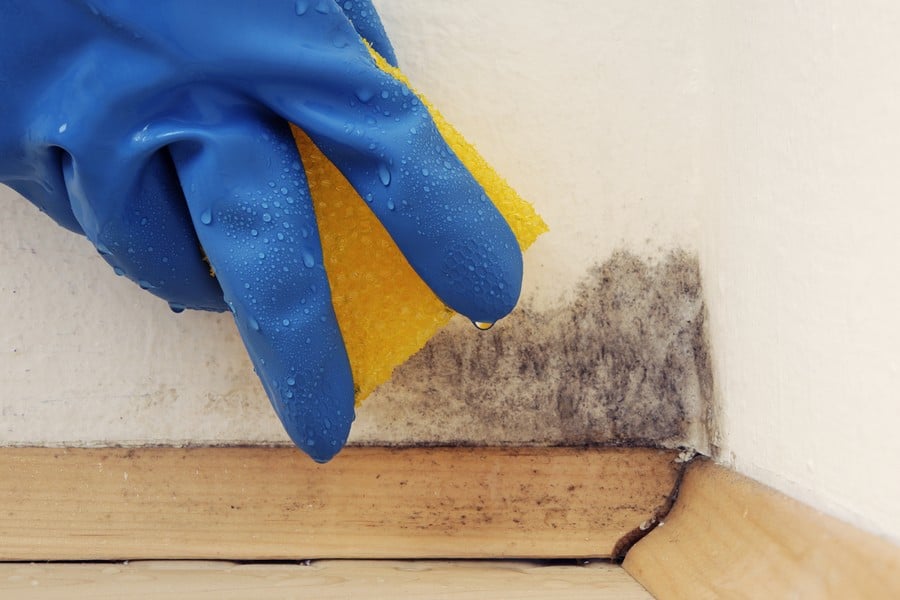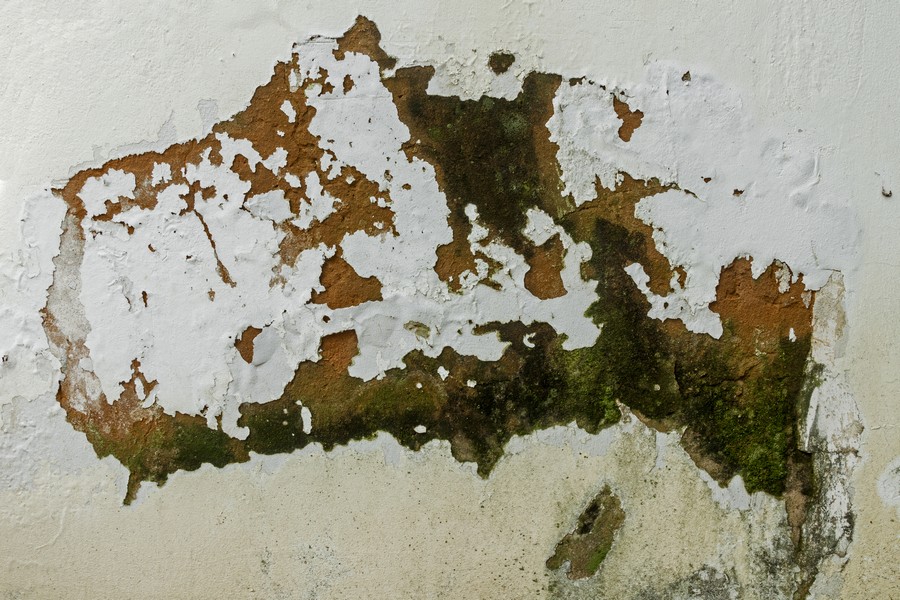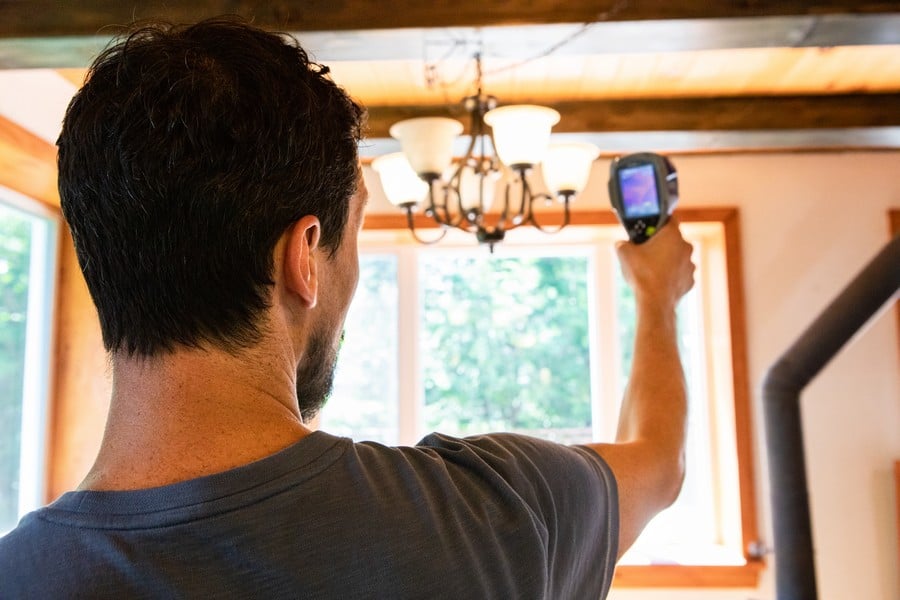Contact Sussex Damp Experts Now to Speak With an Expert.

Rising damp is one of the most discussed and contentious types of damp. If you believe you may have a rising damp problem, you’ve come to the right place. This How-To tutorial will walk you through detecting rising damp, its causes, and how to get help to deal with it successfully. A substantial portion of this tutorial is dedicated to correctly diagnosing rising damp signs in your house and helping to distinguish it from other types of damp. We also debunk some common misconceptions about rising damp and give you an idea of how it should be treated.
Sussex Damp Experts can identify and fix rising damp, eliminate uncomfortable damp patches, and correct poor surface drainage on a damp wall, helping you get a damp-free property. We can also carry wood repairs and install a new damp proof course when needed.
Rising damp is a very common type of moisture that affects building walls. Moisture from the ground rises through the walls as a result of capillary action. This means that groundwater is drawn up through microscopic channels in the bricks like a series of straws. This water contains salts, which move up the wall as well.
Other porous construction elements, such as plasterwork and the timber found in floorboards, joists, and skirtings, are located around the damaged wall. These materials will also readily absorb groundwater, and you may notice signs of wet rot in the wood. For help detecting and treating wet rot, consult our guide.

Rising damp is usually detected by the harm it causes to a building’s internal walls. Plaster and paint erode over time, and wallpaper loosens. At the point where the groundwater has reached, a visible stain emerges on the wall in the form of a tide mark. Salts may bloom on the interior surface as well. This is a common symptom of rising humidity and can result in paint and plasterwork debonding. Mortar may crumble externally, leaving white salt stains on the walls. Later in the guide, we’ll go over the common indicators of growing damp in greater depth.
Rising damp is sometimes confused with condensation damp, which is one of the most prevalent causes of misdiagnosis.
Specilaists in the industry refer to BS5250: 2011 that states: “One of the most reliable ways that may be used to differentiate between dampness due to condensate and due to rising damp is to compare moisture in the contents of samples of masonry, or preferably mortar, from within the depth of the wall and near the inner surface of the wall; samples from within the wall will not be damp if surface condensation is the sole cause.”
In other circumstances, rising damp is correctly diagnosed, but the contractor fails to treat it. In most cases, this is due to a failed injection of a chemical DPC cream. The wrongly inserted chemical DPC, unsurprisingly, does not work. Both of these scenarios result in a disappointed and often angry customer, as well as a harmed industry.
The truth is that rising damp is a real problem that affects some homes. It’s a genuine and severe issue that has to be addressed by qualified professionals with care and attention.
With Sussex Damp Experts, you can rely on our services provided by an expert team of professionals with 20 years of combined experience. We offer a guarantee on all our work and materials used to give you peace of mind when addressing your property’s damp problems.
If you are concerned about a damp problem at your property, please call us today on 01273 257 765 to discuss the situation and have expert advice on how to deal with the situation in the best way possible.
Contact Sussex Damp Experts Now to Speak With an Expert.
The tidal lines on your wall above the skirting, as well as powdery white salt deposits, are common signs of rising humidity. It has the potential to cause plaster to bubble and wallpaper to peel.
Both internal and external walls can be affected by rising damp. Keep an eye out for the following indicators of rising damp:
The smell of rising damp is challenging to distinguish from other types of damp since it has a moist and musty odour.
For many years, buildings have been designed with physical DPCs to prevent increasing moisture from harming walls. These physical barriers, however, do not always keep rising moisture at bay. Physical DPCs, especially in older homes, can become damaged over time or, in rare circumstances, were installed incorrectly.
Building work can also damage built-in physical DPCs when houses are being modernised or extended. The physical DPC layer can be bridged by changing the ground level, for example, and rising damp can occur where there was none previously. In such circumstances, a repair DPC must be erected to prevent the recurrence of rising moisture.
The ascent of moisture through capillaries in masonry is known as rising damp in walls or ascending capillary moisture. Capillaries are elongated, tiny tubes with extremely small interior diameters. These tubes come in a variety of thicknesses in masonry and can, in some situations, generate voids. The surface tension becomes more potent as the capillary’s diameter decreases. The impact of capillary action is created by this capillary force, which arises from surface tension, causing moisture to rise. Moisture rises faster when capillaries are smaller.
The rise of moisture in capillaries against gravity is referred to as capillary action. Both in medicine and nature, the impact of capillary action is exploited. Capillaries serve as a water-conducting system for plants. Capillary action can have detrimental consequences in brickwork with thin piliform tubes, resulting in rising damp.

To prevent water from coming up from the ground, most structures have a barrier constructed at the wall’s lower level. A damp proof course is what it’s called (DPC). Depending on the period in which the property was built, these can be made of non-absorbent, water-resistant materials such as slate, bitumen, or plastic. These physical DPCs may fail over time, or they may not exist at all in older homes. There is nothing to stop water from travelling up your wall if you don’t have a DPC or have evidence that it has failed.
The DPC can sometimes be left untouched, but it can also be bridged. Because of a design flaw (or different conditions surrounding the property), damp from the ground might travel up past the DPC. Examples include:
Rising damp on inside walls is usually the first sign of a problem. Rising damp frequently leaves tide marks on your interior walls up to the height at which the water has reached. These tide mark stains usually emerge up to a metre above the skirting board in most situations. Water can travel beyond this limit in extremely uncommon circumstances.
The height to which the water rises is determined by several factors. The pore structure of bricks and mortar and the rate of evaporation is among them. Water will rise higher through masonry with a high proportion of fine pores than through masonry with fewer pores. Rising damp can occur at heights of up to 1.5 metres, and in very unusual cases, even higher.
Salts are frequently present in groundwater, which are then deposited on the wall as the water evaporates. These salts can cause paint to bubble up and leave a fluffy white deposit on the surface. Sulphates, which cause crusty white patches, and invisible hygroscopic salts such as nitrates and chlorides are the primary forms of salt. Hygroscopic salts continue to draw moisture and must be handled as a result.
As described above, there are some common signs of rising damp. They can also be seen on the outside walls.
Rising damp in external walls is caused by the same capillary process that moves groundwater up through the masonry. It occurs when a DPC fails or does not exist or when the DPC has been bridged.
Keep an eye out for tidal markings if you’re looking for evidence of rising dampness on walls. There may be some mortar disintegrating between the bricks or stones, as well as salt deposits.
Rising damp is a significant issue that, if left addressed, can cause structural damage. It’s incredibly unpleasant to live with because of the damage it may do to your plaster, flooring, and decorative finishes, as well as the stench. Like most types of damp, rising damp is terrible for your health and can make some respiratory diseases worse. It can also contribute to more significant energy expenditures due to increased heat loss.
Plaster, wallpaper, paints, and skirting boards are frequently affected by rising damp. To remedy the consequences of rising damp, the source of the problem must be addressed and the décor on internal walls.
A damp proofing injectable cream is the most effective and cost-effective technique to treat rising damp. You have the option of purchasing whole kits or individual cream cartridges.
The cream is injected or pumped into specified holes in the mortar course by hand. The moist proofing cream reverts to a liquid once inserted. This permits it to penetrate the bricks and absorb all of the liquid. As it cures, it forms a strong, water-repellent barrier, as well as a new molecule called DPC, which prevents water from climbing up the wall.
Alternatively, a new damp proof membrane can be installed as a damp proof course. This is a far more involved and time-consuming procedure that entails removing each brick along the damaged mortar course and replacing it with a new physical damp proof barrier.
When a house is built with a DPC, the builders will usually install a stainless steel or plastic sheet Damp Proof Course – it’s more challenging to do this after the house is built, though you can vibrate stainless steel sheet into your walls using saw cut slots if you want to – this will, however, require the services of a tradesman. There are a variety of simpler DPC retrofit alternatives available, including:
If you have a cavity wall, you will need to install your DPC on both the internal and external walls, regardless of which method you pick. If your outside ground level is higher than your interior floor level, dig a trench along your external wall deep enough for your DPC to be level with your concrete floor or under your raised wood floor inside.
If installed appropriately, chemical injections are quite successful at treating rising damp. Over time, the formulas have evolved and are now shown to give long-term protection.
It’s necessary to remove any wallpaper and plaster back to the bricks or substrate if there is evidence of rising dampness on internal walls. This will also need to be done on the property’s exterior wall.
Before injecting a new DPC, double-check that the old one hasn’t been bridged in any way. When it comes to treating rising damp on internal walls, it all boils down to following the above injection technique and then making good and redecorating internally.
A moisture-proof membrane is the quickest way to accomplish this, also known as the damp proof membrane (DPM).
After addressing the source of the wetness, the décor can be repaired. Alternatively, the wall can be re-plastered with a variety of damp-resistant products.
After injecting the new DPC, the affected area will need to be re-plastered. Unless completely removed, the old plasterwork will likely contain hygroscopic salts that will continue to attract moisture. It’s critical that you have the plasterer re-plaster to an exact specification to avoid further salt contamination issues.



If you suspect a property has a rising damp problem, you should get a professional diagnosis to validate your fears. A competent damp surveyor, rising damp treatment professional, or preservation firm with experience with rising damp injection therapy should be your first choice. The surveyor will do a rising damp inspection, conduct a thorough analysis, and then recommend a remedy based on their results. When picking who will cure your rising damp problem, we recommend looking for certain qualities.
The surveyor should ideally possess the following industry-recognised professional credentials:
Rising damp is the landlord’s responsibility if you live in a rented house. They should hire an expert to diagnose and treat the damp, being sure to rule out other possibilities first.
Because we know damp problems shouldn’t be taken lightly, Sussex Damp Experts have a fully qualified and certified (CSRT and CSSW) team ready to help you deal with these concerns. Whether it’s a rising damp problem, penetrating damp, excessive condensation, building defects or damages, re-structuring basements or cellars, wet rot and dry rot repairs and treatments or damp proofing and re-plastering wall, our competent team will help you identify, treat and resolve all those issues and get peace of mind to be able to enjoy the advantages of a damp-free and damp protected property for a long time.
The costs associated with addressing a damp problem depend on many different factors such as the property’s dimension and architecture, the type of damp causes, the materials involved, among others.
Because there’s a comprehensive range of details to consider, don’t hesitate to contact our fully trained team on 01273 257 765 to book a survey and have one of our friendly team members inspect the property and help you fully understand the situation, thus providing you with the most cost-effective quote for treatments and repairs.
We follow excellent standards in damp proofing treatments, professional re-plastering, wood preservation and are experts in performing damp surveys.
We provide highly customised, competent, and dependable damp proofing treatment and repair services to homes, local authorities, small businesses, and large commercial properties.
If you are experiencing damp issues in Brighton and the surrounding areas, please call our damp specialist team on 01273 257 765 to schedule a survey or treatment. Following our instructions, one of our CSRT and CSSW trained surveyors will thoroughly examine and provide a report, price quote and treatment suggestions.
Suppose you decide to go ahead with our damp proofing services. In that case, we have a complete team of damp proofing specialists who have a comprehensive portfolio dealing with damp problems, such as dry rot and woodworm, wet rot, wood rot, basement waterproofing, all types of internal dampness, rain penetration, condensation control both in commercial properties and private homes.

For your safety and security, all of our work is covered by our company’s guarantee. We are also members of the Guarantee Protection Scheme, an independent insurance policy that covers the duration of your guarantee if you want to take it out.


Max and his team have been at our property all week and I really can’t thank them enough for the fantastic job they’ve done on plastering both our walls and ceilings. They have literally transformed the appearance of our house! Not only has Ma…

From start to finish Max has been incredable. His knowledge lin damp proofing is second to none and his team where very clean and polite. The plastered finish was like glass so happy we choose Max Plastering for job.

Lovely bunch of lads left a very neat and clean job. Problem was solved.

Perfect Finnish and all left clean and tidy and no mess. Used Max previously and would not hesitate to ask him carry out more work.

Max, Harvey and Stuart arrived promptly as arranged. Done a great job on our outside rear wall. Work completed to a high standard, removal of all old material and cleaned up after themselves. I am so pleased with the standard of their work they ar…

They turned up on time and carried out the works in a very professional manor leaving the front of the house clean and tidy. Very impressed would definitely recommend.

I have to say that on every level Max (with Stuart and Harvey) did an extremely professional job! They explained what they were going to do, they were polite and courteous and respected that they were coming into our home. The plastering is of the…

I called max and he managed to come around the same day to do a survey. The next day I received an extremely detailed survey compared to any other damp proofer which made me feel very at ease that he was going to do the right job. Max and team tur…

Contact Sussex Damp Experts Now to Speak With an Expert.